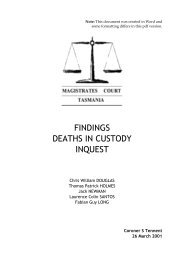Psychological Science in the Public Interest - Williams College
Psychological Science in the Public Interest - Williams College
Psychological Science in the Public Interest - Williams College
You also want an ePaper? Increase the reach of your titles
YUMPU automatically turns print PDFs into web optimized ePapers that Google loves.
Psychology of Confessions<br />
Hilgendorf, E.L., & Irv<strong>in</strong>g, M. (1981). A decision-mak<strong>in</strong>g model of<br />
confessions. In M. Lloyd-Bostock (Ed.), Psychology <strong>in</strong> legal<br />
contexts: Applications and limitations (pp. 67–84). London:<br />
MacMillan.<br />
Hill, M.D. (2003). Identify<strong>in</strong>g <strong>the</strong> source of critical details <strong>in</strong> confessions.<br />
Forensic L<strong>in</strong>guistics, 10, 23–61.<br />
Holmberg, U., & Christianson, S.-A. (2002). Murderers’ and sexual<br />
offenders’ experiences of police <strong>in</strong>terviews and <strong>the</strong>ir <strong>in</strong>cl<strong>in</strong>ation<br />
to admit and deny crimes. Behavioral <strong>Science</strong>s and <strong>the</strong> Law, 20,<br />
31–45.<br />
Holmes, W. (2003). Crim<strong>in</strong>al <strong>in</strong>terrogation: A modern format for <strong>in</strong>terrogat<strong>in</strong>g<br />
crim<strong>in</strong>al suspects based on <strong>the</strong> <strong>in</strong>tellectual approach.<br />
Spr<strong>in</strong>gfield, IL: Thomas.<br />
Home Office. (1985). Police and Crim<strong>in</strong>al Evidence Act of 1984.<br />
London: Her Majesty’s Stationery Office.<br />
Horselenberg, R., Merckelbach, H., & Josephs, S. (2003). Individual<br />
differences and false confessions: A conceptual replication of<br />
Kass<strong>in</strong> and Kiechel (1996). Psychology, Crime and Law, 9, 1–18.<br />
Huff, C.R., Rattner, A., & Sagar<strong>in</strong>, E. (1986). Guilty until proven<br />
<strong>in</strong>nocent: Wrongful conviction and public policy. Crime and<br />
Del<strong>in</strong>quency, 32, 518–544.<br />
Inbau, F.E., Reid, J.E., Buckley, J.P., & Jayne, B.C. (2001). Crim<strong>in</strong>al<br />
<strong>in</strong>terrogation and confessions (4th ed.). Gai<strong>the</strong>rsberg, MD: Aspen.<br />
Innocence Project. (2001). [Home page]. Retrieved March 11, 2005,<br />
from http://www.<strong>in</strong>nocenceproject.org/<br />
Irv<strong>in</strong>g, B. (1980). Police <strong>in</strong>terrogation: A case study of current practice<br />
(Royal Commission on Crim<strong>in</strong>al Procedure Research Study No.<br />
2). London: Her Majesty’s Stationery Office.<br />
Irv<strong>in</strong>g, B., & Hilgendorf, L. (1980). Police <strong>in</strong>terrogation: The<br />
psychological approach (Royal Commission on Crim<strong>in</strong>al Procedure<br />
Research Study No. 1). London: Her Majesty’s Stationery<br />
Office.<br />
Jayne, B.C. (1986). The psychological pr<strong>in</strong>ciples of crim<strong>in</strong>al <strong>in</strong>terrogation.<br />
In F. Inbau, J. Reid, & J. Buckley (Eds.), Crim<strong>in</strong>al <strong>in</strong>terrogation<br />
and confessions (3rd ed., pp. 327–347). Baltimore:<br />
<strong>Williams</strong> & Wilk<strong>in</strong>s.<br />
Johnson, M.B. (2003). The <strong>in</strong>terrogation of Michael Crowe: A film<br />
review focused on education and tra<strong>in</strong><strong>in</strong>g. American Journal of<br />
Forensic Psychology, 21, 71–79.<br />
Jones, E.E. (1990). Interpersonal perception. New York: Freeman.<br />
Kamisar, Y. (1995). On <strong>the</strong> ‘‘fruits’’ of Miranda violations, coerced<br />
confessions and compelled testimony. Michigan Law Review, 93,<br />
929–1010.<br />
Kamisar, Y., LaFave, W.R., Israel, J.H., & K<strong>in</strong>g, N.J. (2003). Modern<br />
crim<strong>in</strong>al procedure (10th ed.). St. Paul, MN: West Publish<strong>in</strong>g.<br />
Karlsen, C.F. (1989). The devil <strong>in</strong> <strong>the</strong> shape of a woman: Witchcraft <strong>in</strong><br />
colonial New England. New York: V<strong>in</strong>tage.<br />
Kass<strong>in</strong>, S.M. (1997a). False memories aga<strong>in</strong>st <strong>the</strong> self. <strong>Psychological</strong><br />
Inquiry, 8, 300–302.<br />
Kass<strong>in</strong>, S.M. (1997b). The psychology of confession evidence. American<br />
Psychologist, 52, 221–233.<br />
Kass<strong>in</strong>, S.M. (1998). More on <strong>the</strong> psychology of false confessions.<br />
American Psychologist, 53, 320–321.<br />
Kass<strong>in</strong>, S.M. (2002, November 1). False confessions and <strong>the</strong> jogger<br />
case. New York Times, p. A31.<br />
Kass<strong>in</strong>, S.M. (2004a). True or false: ‘‘I’d know a false confession if I<br />
saw one.’’ In P. Granhag & L. Strömwall (Eds.), Deception detection<br />
<strong>in</strong> forensic contexts (pp. 172–194). Cambridge, England:<br />
Cambridge University Press.<br />
Kass<strong>in</strong>, S.M. (2004b, April 26). Videotape police <strong>in</strong>terrogations. The<br />
Boston Globe, p. A13.<br />
Kass<strong>in</strong>, S.M. (2005). On <strong>the</strong> psychology of confessions: Does <strong>in</strong>nocence<br />
put <strong>in</strong>nocents at risk? American Psychologist, 60, 215–228.<br />
Kass<strong>in</strong>, S.M. (<strong>in</strong> press). Coerced-<strong>in</strong>ternalized false confessions. In M.<br />
Toglia, R. L<strong>in</strong>dsay, D. Ross, & J. Read (Eds.), Handbook of<br />
eyewitness psychology: Vol. 1. Memory for events. Mahwah, NJ:<br />
Erlbaum.<br />
Kass<strong>in</strong>, S.M., & Fong, C.T. (1999). ‘‘I’m <strong>in</strong>nocent!’’ Effects of tra<strong>in</strong><strong>in</strong>g<br />
on judgments of truth and deception <strong>in</strong> <strong>the</strong> <strong>in</strong>terrogation room.<br />
Law and Human Behavior, 23, 499–516.<br />
Kass<strong>in</strong>, S.M., Goldste<strong>in</strong>, C.J., & Savitsky, K. (2003). Behavioral<br />
confirmation <strong>in</strong> <strong>the</strong> <strong>in</strong>terrogation room: On <strong>the</strong> dangers of presum<strong>in</strong>g<br />
guilt. Law and Human Behavior, 27, 187–203.<br />
Kass<strong>in</strong>, S.M., & Kiechel, K.L. (1996). The social psychology of false<br />
confessions: Compliance, <strong>in</strong>ternalization, and confabulation.<br />
<strong>Psychological</strong> <strong>Science</strong>, 7, 125–128.<br />
Kass<strong>in</strong>, S.M., & McNall, K. (1991). Police <strong>in</strong>terrogations and confessions:<br />
Communicat<strong>in</strong>g promises and threats by pragmatic<br />
implication. Law and Human Behavior, 15, 233–251.<br />
Kass<strong>in</strong>, S.M., Meissner, C.A., & Norwick, R.J. (2005). ‘‘I’d know a<br />
false confession if I saw one’’: A comparative study of college<br />
students and police <strong>in</strong>vestigators. Law and Human Behavior, 29,<br />
211–227.<br />
Kass<strong>in</strong>, S.M., & Neumann, K. (1997). On <strong>the</strong> power of confession<br />
evidence: An experimental test of <strong>the</strong> ‘‘fundamental difference’’<br />
hypo<strong>the</strong>sis. Law and Human Behavior, 21, 469–484.<br />
Kass<strong>in</strong>, S.M., & Norwick, R.J. (2004). Why suspects waive <strong>the</strong>ir Miranda<br />
rights: The power of <strong>in</strong>nocence. Law and Human Behavior,<br />
28, 211–221.<br />
Kass<strong>in</strong>, S.M., & Sukel, H. (1997). Coerced confessions and <strong>the</strong> jury:<br />
An experimental test of <strong>the</strong> ‘‘harmless error’’ rule. Law and<br />
Human Behavior, 21, 27–46.<br />
Kass<strong>in</strong>, S.M., & Wrightsman, L.S. (1980). Prior confessions and mock<br />
juror verdicts. Journal of Applied Social Psychology, 10, 133–<br />
146.<br />
Kass<strong>in</strong>, S.M., & Wrightsman, L.S. (1981). Coerced confessions, judicial<br />
<strong>in</strong>struction, and mock juror verdicts. Journal of Applied<br />
Social Psychology, 11, 489–506.<br />
Kass<strong>in</strong>, S.M., & Wrightsman, L.S. (1985). Confession evidence.<br />
In S.M. Kass<strong>in</strong> & L.S. Wrightsman (Eds.), The psychology of<br />
evidence and trial procedure (pp. 67–94). Beverly Hills, CA:<br />
Sage.<br />
Klaver, J., Gordon, R.V., & Lee, Z. (2003, July). Differential effects of<br />
m<strong>in</strong>imization and maximization <strong>in</strong>terrogation techniques and <strong>the</strong><br />
role of plausibility <strong>in</strong> an experimental false confession paradigm.<br />
Paper presented at <strong>the</strong> International and Interdiscipl<strong>in</strong>ary Psychology<br />
& Law Conference, Ed<strong>in</strong>burgh, Scotland.<br />
Koehnken, G. (1987). Tra<strong>in</strong><strong>in</strong>g police officers to detect deceptive<br />
eyewitness statements: Does it work? Social Behavior, 2, 1–17.<br />
Kotlowitz, A. (1999, February 8). The unprotected. The New Yorker,<br />
pp. 42–53.<br />
Kumho Tire Co., Ltd. v. Carmichael et al., 526 U.S.137 (1999).<br />
La Barre, W. (1964). Confession as cathartic <strong>the</strong>rapy <strong>in</strong> American<br />
Indian tribes. In A. Kiev (Ed.), Magic, faith, and heal<strong>in</strong>g:<br />
Studies <strong>in</strong> primitive psychiatry today (pp. 36–49). New York: Free<br />
Press.<br />
Landers, P. (2000, October 6). A false confession jailed Mr. Yakushiji;<br />
<strong>the</strong>n fate <strong>in</strong>tervened. The Wall Street Journal, pp. A1, A8–A9.<br />
Lassiter, G.D. (Ed.). (2004). Interrogations, confessions, and entrapment.<br />
New York: Kluwer Academic.<br />
Lassiter, G.D., Clark, J.K., Daniels, L.E., & So<strong>in</strong>ski, M. (2004,<br />
March). Can we recognize false confessions and does <strong>the</strong> presen-<br />
64 Volume 5—Number 2


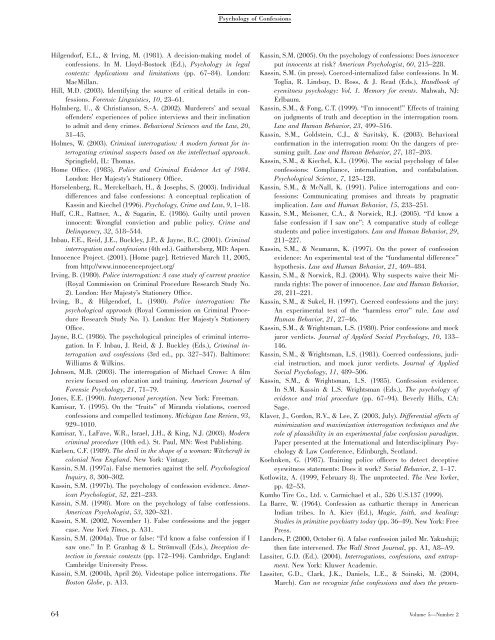
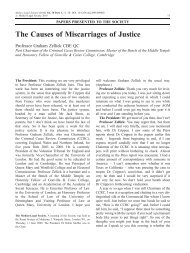
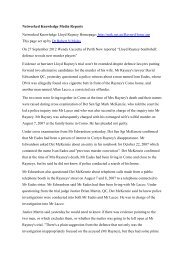

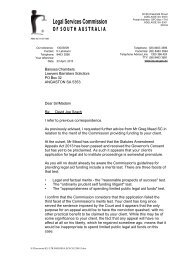
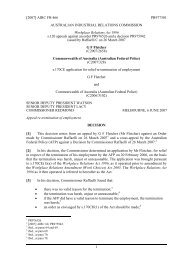
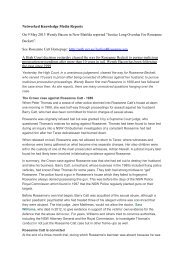
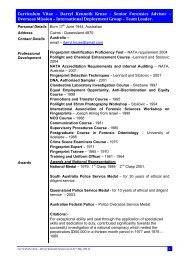
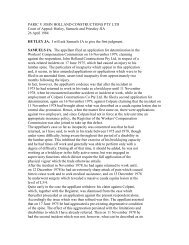
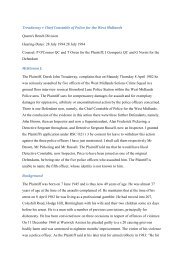
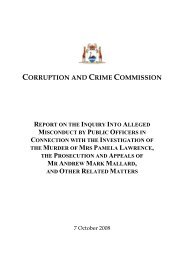
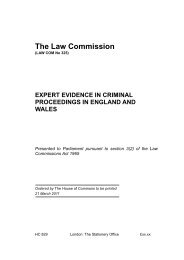

![R v Gilham [2012] NSWCCA 132 - verdicts of acquittal](https://img.yumpu.com/40383571/1/184x260/r-v-gilham-2012-nswcca-132-verdicts-of-acquittal.jpg?quality=85)
